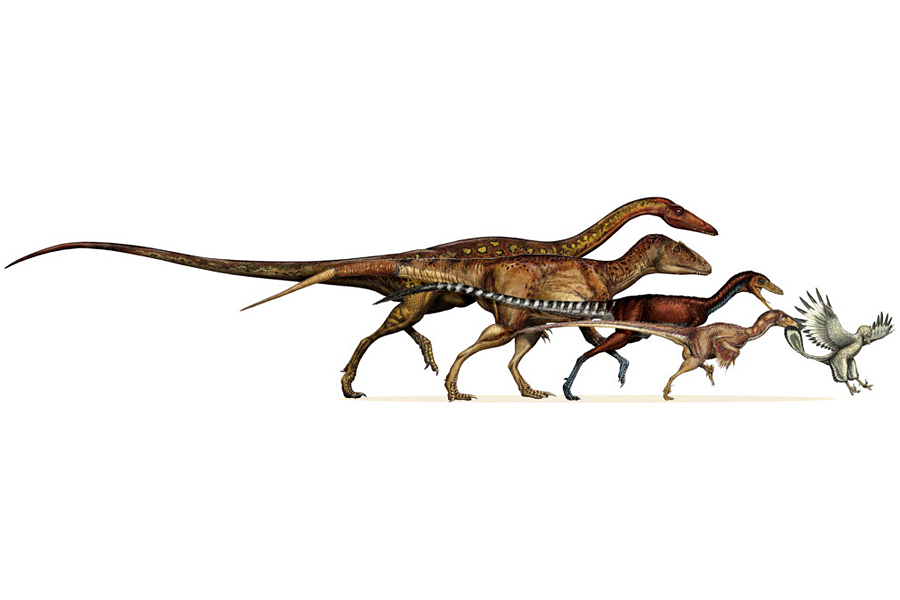How do you get from dinosaur arms to bird wings? It's all in the wrist.
Loading...
Has a team of Chilean scientists finally put an end to the decades-long debate over how birds evolved from dinosaurs? Well, not entirely. But they have clarified some critical details about one small but significant part: the wrist.
Led by University of Chile biologist Alexander Vargas, the team sought to understand how the wrist evolved from a rigid fixture in dinosaurs to the hyperflexible structure found in the wings their only known living descendants. The study's findings, published this Tuesday in the journal PLOS Biology, reveal correlations between wrist bones in various species of dinosaurs and birds, adding details to our picture of how today's avian creatures descend from dinosaurs.
"Dinosaurs forming to birds is not an intuitive concept to most people," says Dr. Vargas. "And this is why it has taken a long time to achieve the current state in science in which this is a well-accepted fact."
But even with a general agreement, developmental biologists and paleontologists have often been at odds over just how this evolutionary process happened. Namely, each field found a different explanation for the drop in the number of wrist bones as birds evolved from dinosaurs. Dinosaurs had as many as nine wrist bones, and today's birds have four bones, an adaptation that allows for the folding of a bird's wings when not in flight.
The two disciplines disagreed, in particular, over a bone known as the semilunate (because of its half-moon shape). In most dinosaurs, the semilunate appears as two distinct bones that have fused together.
Citing evidence from fossils of velociraptors and other birdlike dinosaurs, paleontologists have tended to argue that the semilunate in modern birds is descended from the one found in non-avian dinosaurs. Conversely, biologists, pointing out that the avian semilunate looks like one single bone and not two fused ones, have tended to argue that it has a different origin.
Joao Botelho, a student on Vargas's research team, developed a new method for studying proteins in embryonic skeletons through immunofluorescence, a staining technique that allows scientists to view proteins inside developing skeletons. Thanks to Mr. Botelho's work, the team was able to obtain a much clearer picture of cartilage formation in a bird.
And when Vargas and his colleagues applied the technique, they found that the cartilage in this half-moon shaped bird bone had two distinct centers of formation.
"We were looking at a chicken that looked like a dinosaur," says Vargas of the image, which he described as beautiful. "Our new technique gave us an image of something that looked like a dinosaur."
This discovery was the first piece of developmental evidence identifying the avian semilunate as a composite of two bones that were present in dinosaurs. The paleontologists, it seems, may have been right.
The study also reveals new information about another bone in the wrist called the pisiform, which existed in some dinosaurs but seems to have disappeared in the more birdlike ones. Paleontologists believed that the disappearance of this bone, which they refer to as the ulnare instead of pisiform, meant any similar bone in modern birds must be entirely new. Developmental biologists, however, were certain that the bird wrist contained that same bone, the pisiform, existent in early dinosaurs.
This time, the biologists appear to have been right. The research group found that it was indeed the same bone. The pisiform is connected by a tendon to a muscle that runs along the forearm, and the immunoflourescence images exhibited this characteristic muscular connection in modern birds.
While a reemergence of a bone is rare, it is not unprecedented. Vargas attributes the loss of the pisiform in bird-like dinosaurs to a freeing of the arm as a way of developing flight.
"Definitely there was a stage in which they did not use their arms that much, at least not for walking," says Vargas. "And this liberated the arm to evolve new functions."
Vargas's team used Botelho's technique to collect developmental data and also examined a number of fossils, an integrative method that is Vargas says is being utilized by other scientists but is not yet the norm.
"I don't feel that mainstream yet," says Vargas.
The interdisciplinary way Vargas's group carried out the study allowed for a kind of cross-checking that is absent when paleontologists focus only on fossils and biologists rely on data collected in the lab.
"None of the fields separately would have arrived at the right conclusion," says Vargas.








